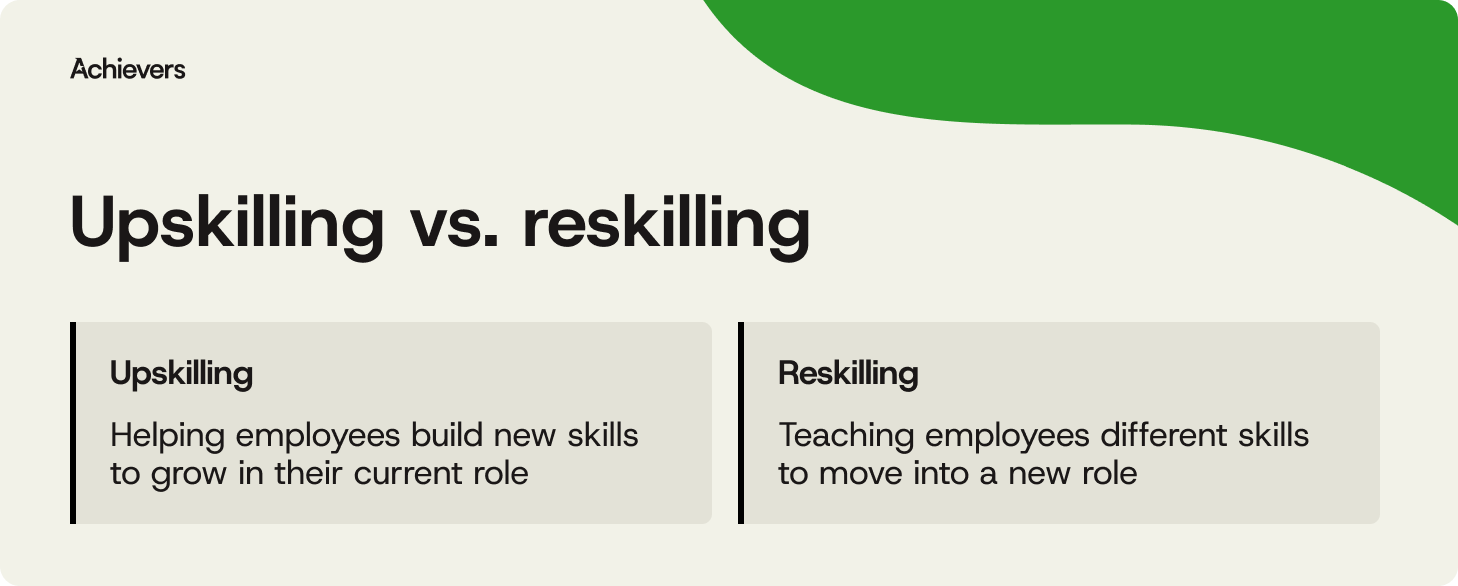Table of contents
Create a culture that means business™
Schedule a demo with an Achievers solution expert today.
In a workplace that’s evolving faster than most job descriptions, one thing’s clear: if you want your people to keep up, you’ve got to help them grow — or risk losing them.
And the pressure’s mounting. According to the World Economic Forum, 44% of workers’ skills are expected to be disrupted in the next five years — and by 2027, six in ten employees will need to either upskill or reskill. The future of work isn’t around the corner. It’s already at your door.
That’s why upskilling and reskilling matter. They’re survival strategies. One helps employees grow where they are. The other helps them shift into something new. Different moves, same goal: a workforce built for what’s next.
But here’s the catch — skills don’t stick without support. Learning only leads to real change when employees feel recognized for the effort.
Because when people feel seen, they lean in. And that’s when growth takes off.
Upskilling vs. reskilling: Key elements
Not all growth looks the same — and neither does the support it takes to make it stick. Upskilling and reskilling are two sides of the same talent development coin, but they serve different needs, trigger different behaviors, and send employees down very different paths.
Before you roll out a strategy, it helps to get clear on what each one actually involves — and why that matters.

What it means
- Upskilling: Building new skills to do your current job better. That might mean mastering a new tool, learning how to lead a team, or staying ahead of a fast-changing field.
- Reskilling: Learning a new skill set to move into a different role. It’s a bigger leap — say, helping a warehouse employee shift into customer service, or training an admin to become a data analyst.
Why you use it
- Upskilling: To help people stay sharp, adaptable, and ready for what’s next in their existing role.
- Reskilling: To help people pivot into new roles when their current one is changing, evolving, or disappearing altogether
Type of learning
- Upskilling: Layered learning — adding onto what someone already knows. It might be a certification, advanced project work, or just-in-time training tied to their day-to-day.
- Reskilling: Ground-up learning — usually more structured and immersive. Think bootcamps, hands-on training, or mentorship in a new discipline.
Employee mindset
- Upskilling: “I want to be great at what I do, and I’m ready to stretch.” These employees are motivated, curious, and eager to stay relevant in their roles. They’re not looking to leave — they’re looking to grow.
- Reskilling: “I’m ready for something new. Where do I fit next?” Reskilling often comes with uncertainty. These employees may be worried about change, unsure about their future, or simply ready for a fresh challenge. What they need most? Encouragement, clarity — and recognition at every step.
Upskilling vs. reskilling: Strategies that stick
Knowing the difference between upskilling and reskilling is a good start. But if you want either to work, you need more than a learning program. You need a strategy that connects to people’s real goals, challenges, and motivations.
Here’s how to make both strategies land — and last:
Start with a plan
- Upskilling: Start by identifying what skills your teams need to stay sharp — not in five years, but right now. Use manager insight, employee feedback tools, and business priorities to map out practical, role-relevant learning goals. Keep it grounded.
- Reskilling: Begin by spotting the roles that are shifting — or at risk of becoming obsolete — and look for people who are ready to pivot. Match potential with possibility. And make sure employees know: this isn’t about being replaced. It’s about being re-invested in.
How people learn
- Upskilling: Make it part of the day-to-day. That might mean mini-trainings, peer coaching, or project-based stretch work. The best upskilling doesn’t feel like “extra” — it feels like momentum.
- Reskilling: This one needs more structure. You’re not just topping up; you’re retraining from the ground up. Think guided learning, hands-on support, and clear check-ins. And remember: new doesn’t have to mean overwhelming, but it does need to feel worth it.
What people need
- Upskilling: Recognition when they apply what they’ve learned, not just after it shows results. Progress deserves to be seen in the moment, not just at performance review time.
- Reskilling: Confidence and clarity. People need to know they’re not being pushed off a cliff with a new job title. A supportive manager, a clear path, and steady encouragement make the leap feel possible.
What upskilling and reskilling have in common: recognition
No matter the path — whether someone’s leveling up or starting fresh — growth takes effort. And effort, if left unseen, tends to fizzle.
That’s where recognition comes in. Not as an afterthought, but as fuel. It’s the thing that keeps people going when the learning curve gets steep (or when “new role nerves” kick in). Growth doesn’t happen in silence — it happens when people feel seen, supported, and celebrated along the way.
The recognition effect on professional growth
Recognition turns learning into something employees can actually feel — not just another item on a development plan. It reinforces the behaviors that drive growth:
- Curiosity to try something new
- Consistency to build something real
- Courage to take on the unknown
And the impact? It’s measurable. Employees who are meaningfully recognized at least monthly are 91% more engaged, according to Achievers Workforce Institute. That’s not just a feel-good stat — that’s your retention strategy in action.
Recognition says more than “good job.” It says, “We see what you’re working on — and we’re behind you.”
How to make recognition part of your development strategy
If you want employees to grow, you need to acknowledge the effort it takes to get there. Here’s how to build recognition into the way your people learn, stretch, and succeed.
- Highlight learning milestones: Finished a course? Picked up a certification? Practiced a new skill in a meeting? Call it out. Recognition at these moments reinforces the idea that growth isn’t just encouraged — it’s seen and valued.
- Celebrate the leap, not just the results: Transitions are hard. Whether someone’s stepping into new responsibilities or switching tracks entirely, they’re putting themselves out there. Recognizing the courage to try something new helps build confidence and keeps momentum going.
- Make growth visible across the team: When learning is recognized publicly — from managers or peers — it sends a message: around here, we reward effort, not just outcomes. That visibility normalizes development and helps create a culture where people support one another’s growth.
- Equip managers to recognize in real time: The best recognition happens when it’s timely, specific, and tied to behaviors that matter. With tools like Achievers recognition platform, it’s easy to prompt, track, and scale recognition in the flow of work — so growth moments don’t get missed.
- Use insights to guide what’s next: Recognition data doesn’t just show who’s engaged — it shows who’s growing. With visibility into what skills are being recognized and where gaps might exist, leaders can fine-tune support and keep development aligned to business goals.
The role of leadership in upskilling and reskilling
No program works without people behind it — and that starts with leadership. Managers aren’t just there to approve learning budgets or assign courses. They’re the ones who bring development to life: helping employees see what’s possible, where to grow, and how to get there without burning out.
Here’s how leaders can make upskilling and reskilling actually stick:
Spot the opportunities
- Keep an eye on shifting priorities and evolving team goals — they often signal the need for new skills.
- Use one-on-ones to explore career interests, strengths, and untapped potential.
- Don’t just look at what someone has done — look at what they could do with the right support.
Make learning part of the job
- Assign stretch projects that let employees practice new skills in a real-world setting.
- Proactively block time on calendars for learning — and reinforce that it’s not optional or “nice to have.”
- Tie development efforts to actual outcomes: “Because you took on X, we were able to achieve Y.”
Coach through the change
- Be upfront when roles shift or business needs evolve — uncertainty is easier to navigate with clarity.
- Guide employees through reskilling conversations with empathy and specifics: what’s changing, what’s expected, and what support is in place.
- Create a safe space to ask questions, express doubts, and make mistakes — especially when the learning curve is steep.
Recognize the growth
- Call out effort early, not just results. Learning takes time, and recognition keeps momentum going.
- Celebrate milestones like course completions, role changes, or even first-time contributions in a new area.
- Reinforce growth behaviors publicly, so others see what’s valued and feel inspired to stretch, too.
Upskill, reskill — and recognize every step
Upskilling and reskilling are how companies stay ready for what’s next. But recognition? That’s how people stay ready to grow.
Because learning isn’t just about new skills — it’s about motivation, belonging, and belief. When employees feel recognized along the way, they don’t just complete development — they commit to it.
Recognition makes growth visible. It turns effort into momentum. And it’s the glue that holds your skills strategy together — from stretch projects to career pivots.
So, if you want your workforce to be future-ready, don’t just invest in learning. Invest in the culture that makes learning stick.



